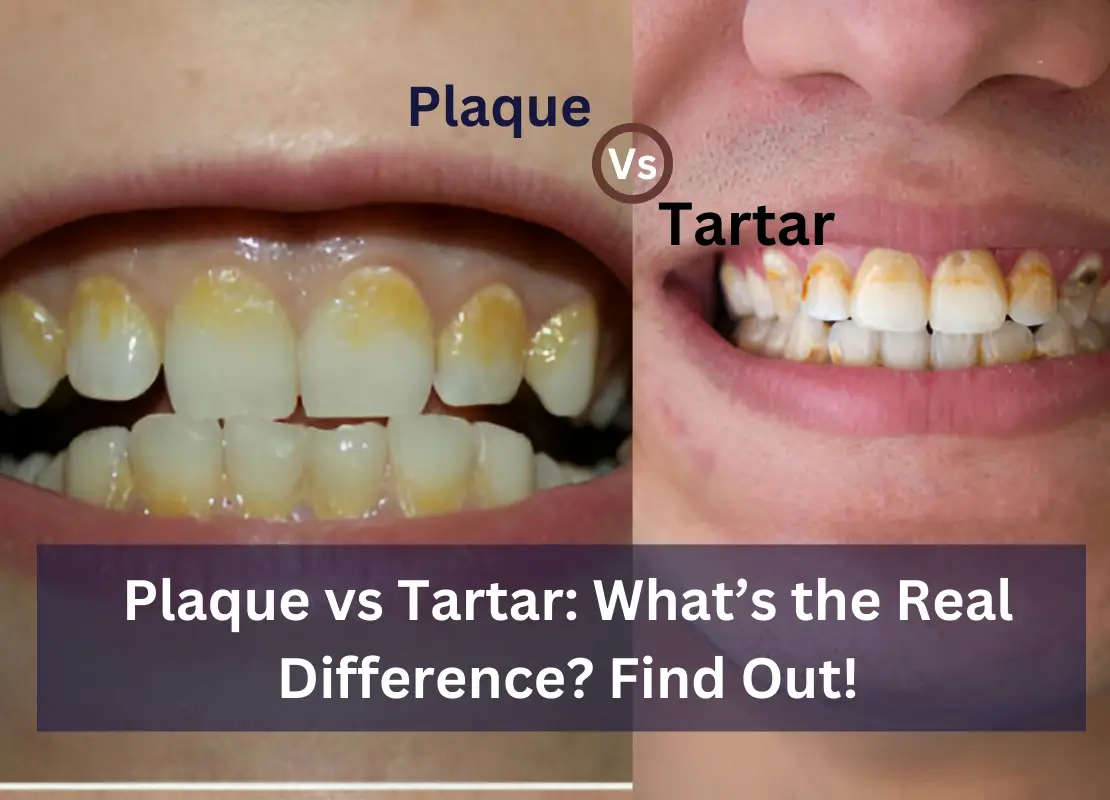Regular eating and drinking leads to bacteria forming a soft film of plaque – starting as a clear film before becoming a yellow film through daily accumulation. While enamel is the hardest substance in your body, this film accumulation makes teeth susceptible to dental issues.
When poor dental hygiene allows plaque to undergo a hardening process, it becomes tartar, requiring professional removal. This buildup leads to dental conditions like cavities, gingivitis, gum disease, and tooth decay. Effective dental care requires attention to warning signs, proper dental maintenance, and preventive care to protect oral health.
Early identification, appropriate measures, and regular visits to a dental professional help prevent dental deterioration, manage risk factors, resolve any confusion, reduce wear and tear, and maintain overall health through proper tooth protection as these substances can progress rapidly, affecting your dental health.
Plaque vs Tartar: What’s the Real Difference? Find Out!(Short Answer)
Plaque Removal and Prevention
Daily brushing, flossing, and dental cleaning combat bacteria that feed on sugar, causing bacterial growth and chronic bad breath. When teeth feel fuzzy teeth or slimy teeth with white goo or yellow goo on dental floss, watch for bleeding gums, painful gums, and inflammation in pockets beneath gums.
Those with oral appliances, braces, or retainers need extra care. Regular dental appointments for dental scaling by a dental professional prevent gum disease, swelling, and tooth decay. Combine fluoride toothpaste and fluoride treatment from your dentist with managing lifestyle factors, smoking, high-sugar diet, stress, and genetic risk factors.
Proper oral health care, teeth cleaning, dental care, and dental hygiene protect gums from tartar, while preventive measures address plaque buildup.
Professional Tartar Management
Tartar or calculus requires professional cleaning by a dental professional. Avoid home removal through scratching or pulling as it causes teeth damage. When you notice warning signs like discolored spots, hard patches, rough patches, swollen gums, painful gums, or bloody gums, especially with crooked teeth, your dentist will perform dental procedures like scaling and root planing.
This plaque removal focuses on the gumline and between teeth across the tooth surface. While regular maintenance through brushing, flossing, and dental hygiene helps in buildup prevention, certain risk factors can create cleaning difficulty.
Follow dental recommendations about oral care, including specific toothpaste formulas and preventive care to manage dental complications and dental condition affecting your gums.
Understanding Plaque Formation
Think of plaque as a stealthy invader in your mouth – a sticky film of bacteria mixing with saliva and food particles. This soft film contains over 500 species of organisms that feast on sugary substances and drinks, producing harmful acids. Through acid production, they attack your teeth’s enamel.
This detrimental buildup can harden into calculus or tartar, making gums tender and swollen, potentially triggering periodontal disease or gum disease. As a dental professional, I emphasize maintaining proper oral hygiene: brush twice daily, perform daily flossing, and schedule regular checkup visits every six months for cleaning and maintenance as crucial preventive care for optimal health.
What Causes Plaque on Teeth?
When bacteria in your mouth mixes with food and drink, it initiates bacterial action that produces harmful acids. These acids attack the outer layer of your teeth – the enamel, leading to layer breakdown.
In my years as a dentist, I’ve seen how dental plaque builds up faster when you consume sugary foods and sugary drinks, causing severe break down of dental surfaces.
What Does Plaque Look Like?
Plaque is a soft, sticky layer that typically appears colourless and feels fuzzy when you run your tongue over it. It can sometimes appear as a pale yellow tint.
What’s Tartar?
When residual plaque on your teeth mixes with minerals in saliva, it creates a crusty deposit. This hard deposit, called tartar or calculus, combines and hardens on the tooth surface, causing stains and discoloration on the exterior and below the gum line.
The CDC reports 48 percent of adults over age 30 develop periodontal disease, starting with gingivitis (with swollen gums, red gums, bleeding gums) and potentially leading to periodontitis where gums pull away, teeth loosen and fall out.
Only a dental professional or dentist can remove it through cleaning, which is why proper hygiene and daily protocol of brushing and flossing prevents buildup.
What Causes Tartar on Teeth?
When patients skip their regular brushing and flossing routines daily, plaque on their teeth combines with minerals in their saliva to turn into tartar. In my dental practice, I’ve noticed certain patients are more susceptible to buildup, particularly those with dental appliances like braces, oral conditions like dry mouth or crowded teeth, and smokers who smoke. These risk factors make them more prone to tartar formation.
What Does Tartar Look Like?
Tartar has a rough, hard texture and is typically yellow or brown in colour. It tends to settle around the outer surface of your teeth and can also build up beneath your gum line.
What are the key differences?
Although tartar and plaque can both lead to dental health problems, there are some key differences to highlight.
The buildup process is different
When dental plaque, a sticky substance, naturally builds on teeth after eating and drinking sugary foods, beverages, and carbohydrates, it can be managed through regular brushing and flossing in your daily routine. If not removed, plaque turns and hardens into tartar that accumulates and becomes more difficult to clean.
Appearance and Feel
A soft, thin, slimy film called plaque appears transparent, white, or colorless on teeth each day, creating a fuzzy feeling when you rub your tongue across them. If left, it becomes tartar, a hard, rough, crusty deposit that often turns yellow, brown, and discoloured, leaving a pale yellow stain.
Removal Methods
While dental plaque can be removed with daily brushing and flossing twice a day after eating sugary foods, tartar that bonds to tooth enamel needs a dental professional. Though home methods exist to clean teeth, professional care ensures the best outcome without risk of oral complications.
How to Prevent Dental Plaque and Tartar Buildup
To prevent tartar buildup, remove plaque by brushing and flossing regularly. Plaque can turn into tartar in hours, so a daily dental hygiene routine is crucial.The following oral health tips can help you remove plaque and prevent its buildup:
- Brush your teeth twice a day for 2 minutes using fluoride toothpaste to protect enamel.
- Use an electric toothbrush for better plaque removal.
- Floss at least once a day to clean between your teeth.
- Limit sugary foods and beverages; brush and floss afterward.
- Get regular dental checkups every 6 months for a professional cleaning.
- Quit smoking to lower the risk of plaque, tartar, and oral diseases.
What happens if plaque isn’t removed?
Not maintaining proper oral hygiene can cause dental caries and dental cavities. Cavities are damaged areas of the teeth that form holes, which need to be sealed by a dentist.
If plaque turns into calculus (tartar), it can lead to gingival recession, where the gum tissue pulls away from the teeth, exposing the tooth root. Left untreated, this can cause periodontal damage and tooth loss.Tartar accumulation can lead to periodontal disease. Common symptoms of periodontal disease include:
- Gingival inflammation (red or swollen gums)
- Gum bleeding
- Halitosis (bad breath)
- Dental hypersensitivity (sensitive teeth)
Controlling plaque accumulation is crucial before it progresses into calculus (tartar) to prevent oral health issues like dental caries, periodontal disease, and gingival recession.
Conclusion
In conclusion, plaque is a soft, sticky film that can harden into tartar if not removed, leading to serious dental issues like cavities and gum disease. Regular brushing, flossing, and professional cleanings are essential to prevent plaque buildup and manage tartar. Early detection and proper dental care are key to maintaining optimal oral health.

